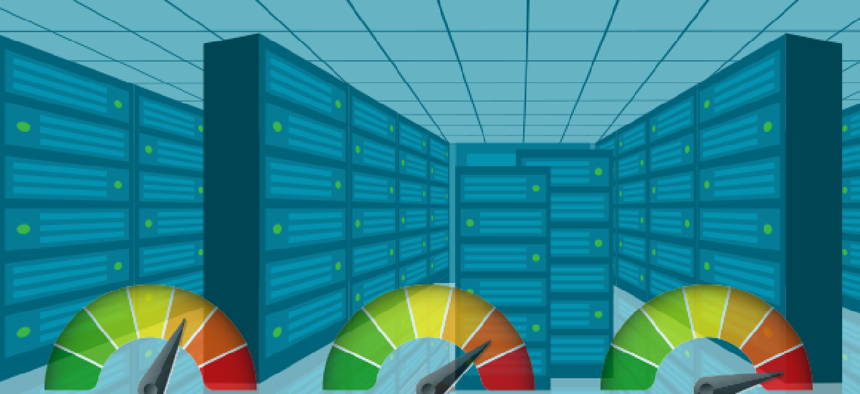Back to the basics with software-defined data centers


Connecting state and local government leaders
Traditional monitoring and management techniques can help government IT administrators deliver an automated, scalable and highly agile networking environment.
We’ve been talking about software-defined data centers in federal IT for several years, and yet the concept still causes some head scratching among network managers. They understand the benefits of SDDCs, yet many are still uncertain about how to efficiently manage those virtual environments. To paraphrase a former colleague, it is like herding cats that are being chased by dogs that just escaped from the kennel.
As the federal government continues its march toward network modernization, many agency IT professionals have already implemented (or are considering) SDDCs, in which all elements of an IT infrastructure are abstracted, pooled and automated. SDDCs involve taking traditional hardware appliances and creating an automated, scalable and highly agile networking environment. They are the true realization of IT as a service (ITaaS).
Such an environment introduces some intricate challenges and pain points. First, there’s the need to efficiently and effectively manage configuration challenges across different abstracted layers. This is crucial to SDDC success and can be more easily handled by agencies that have adopted DevOps principles.
Second, there is the matter of service-level agreements (SLAs) that must be delivered to key stakeholders. Administrators must be able to quantify and qualify the IT services they’re delivering and ensure that those services are worthy of investment.
Despite the complexities of SDDCs, federal IT professionals can -- and should -- apply many of the same core network management disciplines and principles to their new ITaaS environments. Let’s take a closer look at how those strategies can overcome SDDC challenges.
Expand system monitoring to the SDDC
Network monitoring has become fairly commonplace within government IT. Administrators routinely use tools to gain visibility into their infrastructures and alert them to potential slowdowns or anomalies. Many have successfully incorporated 24/7, automated monitoring into their arsenals.
With the right tools in place, monitoring can be successfully translated to an SDDC. Server- and application-monitoring solutions can track performance, capacity and overall health of applications across the data center from a single dashboard. Administrators can get detailed information and insight into the performance of thousands of virtual machines across their data centers.
Incorporating SDDC monitoring as a discipline checks both the change management and SLA challenge boxes, but that's not all administrators can do to cover their bases. IT managers should consider supporting those efforts by using two proven frameworks -- DART and SOAR -- to strengthen their oversight of SDDCs.
The DART framework
The DART framework involves four key disciplines:
Discover -- Administrators should establish a baseline for the performance of their environments. Gaining a better understanding of components’ health and risks -- and their connection to the applications and services that must be supported -- allows IT pros to better manage the changes.
Alert -- Alerts help administrators focus on the most important information so they can quickly ascertain and attack the root cause of problems.
Remediate -- Focused alerts allow administrators to remediate issues at a much faster clip, reducing lost time and enhancing productivity.
Troubleshoot -- Troubleshooting involves solving the right problem the first time, instead of chasing false positives. Again, the goal is to cut through the noise and complexities of the SDDC to solve challenges quickly.
The SOAR framework
Although DART is useful for overall SDDC management, attacking the change management issue might require a more robust set of practices. Enter SOAR, which focuses on helping IT professionals secure, optimize, automate and report on their SDDC environments.
Secure -- Virtual networks require IT professionals to defend multiple planes across different domains. Administrators have their hands full, making it easy to miss potential security breaches. They must remain vigilant to ensure that their SDDC remains secure.
Optimize -- Optimization is more challenging in an SDDC. Administrators must understand the different interactions that are taking place within their enormously complex IT ecosystems, the behavior of their application stacks and the interdependencies of systems both inside and outside their spheres. IT managers must learn to focus on a singular end goal instead of trying to do too much.
Automate -- Automation helps SDDCs reap the greatest agility and scalability benefits. But administrators must simplify automation as much as possible. Automation should be done at a controlled scale (so that it does no harm to the production environment), followed by close monitoring of the entire automation process to ensure that everything is properly executed.
Report -- Administrators should run reports of their findings. Ascertaining how SDDC management is going can help improve the process and create a more streamlined and effective system.
Although some might insist that the term “software-defined data center” is merely a buzzword created by marketers, SDDCs can present some valuable real-world benefits. The key to unlocking those benefits is proper management. Yes, there are some pretty daunting pain points, but use of traditional monitoring and management techniques can help government IT administrators salve those wounds and make the jump to ITaaS far less taxing.




